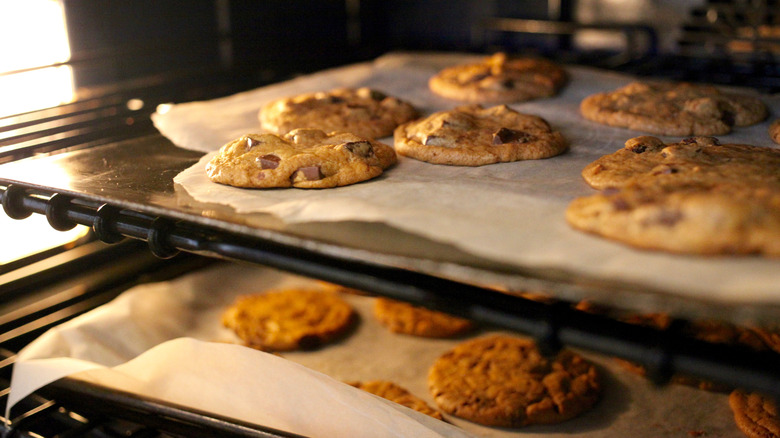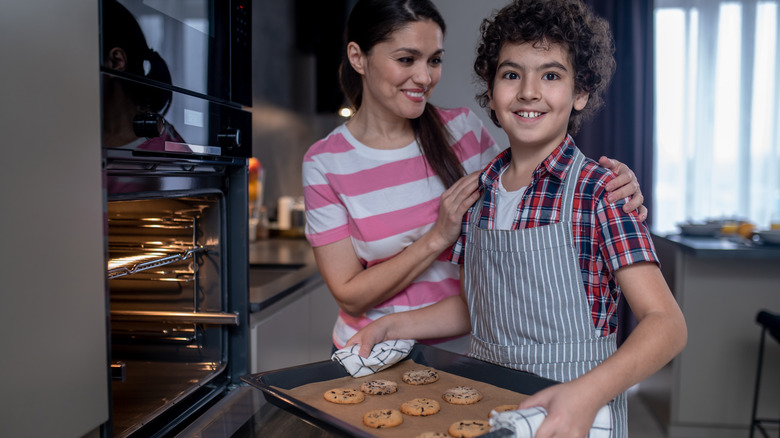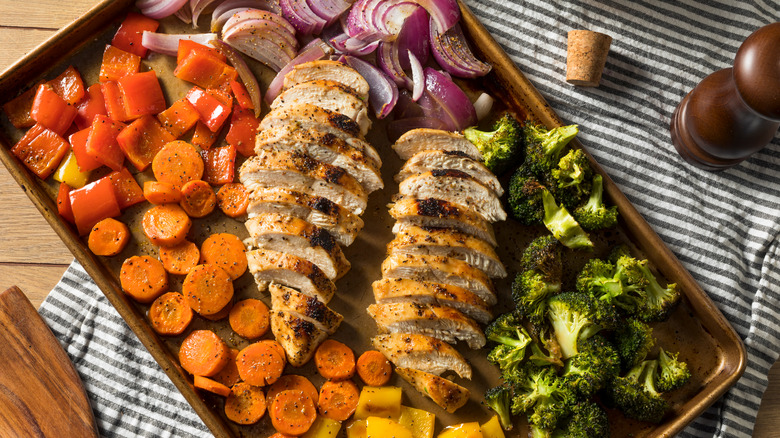Are Cookie Sheets And Sheet Pans Different?
Have you ever noticed that sometimes a recipe will say to bake your food on a sheet pan, while other recipes call for a cookie sheet, and still others sometimes (frustratingly) don't specify a pan at all? When you're baking or roasting, does the pan make a difference? After all, aren't they both just big, flat pieces of metal that get hot in the oven?
When you're shopping for kitchenware, it can be hard to know whether you're spending money on something useful or wasting it on a ridiculous kitchen gadget that you'll only use a few times. This is true with bakeware, too. But when it comes to pans, there really is a difference between the various types.
While sheet pans and cookie sheets have a lot in common and can sometimes work interchangeably, they don't work quite the same way, and each has their own job to do in the kitchen. Google the term "cookie sheet," and you'll see photos of several different varieties of flat baking pans. So, which is which? The name of the pan should hopefully tip you off, but that's not always the case. (Sometimes, a cookie sheet will be called a baking sheet, for instance.) Ultimately, the difference between a sheet pan and a cookie sheet is in the sides of the pan and the thickness of the metal.
Cookie sheets
If you ever baked cookies with your parents growing up, you've probably seen a cookie sheet. They're designed strictly for baking their namesake treats, according to Martha Stewart, and they normally have a lip on one or both of the short sides for easy gripping. The long sides of the pan are flat, which helps the finished cookies slide off easily.
Cookie sheets are sold in a few common sizes, including 16 x 14 inches, 15 x 10 inches, 14 x 13, and 14 x 12 inches. There's no universal, agreed-upon sizing — they just need to fit inside a standard home oven. These pans are ideally made of thin aluminum — The New York Times recommends around 10-gauge so that cookies will crisp up quickly on the bottom. Sometimes these pans have rims on all sides, which you'll typically see with discount department store models. These inexpensive designs are usually too thin and flimsy, and your cookies can suffer from burnt bottoms and undercooked tops.
There are also some sheets made with two thin layers of metal with air in between to prevent burnt bottoms and sold as "insulated" or "air bake." But if you bake a lot of cookies, it's a better investment to buy a couple of professional-grade, single-layer cookie sheets. The cheaper, thinner ones can warp and buckle, and they tend to have a shorter life span.
Sheet pans
The major difference between cookie sheets and sheet pans is that sheet pans have rolled 1-inch edges on all four sides. The edges keep food on the pan from sliding off into the oven, explains Serious Eats.
Sheet pans are standard-issue in commercial kitchens, so they have uniform sizes to make them easy to identify. Full sheet pans are (in inches) 26 x 18, half sheets are 18 x 13, quarter sheets are 13 x 9.5, and eighth sheets are 6.5 x 9.5. You might also come across "jelly rolls," which are 15 x 10 and designed specifically for making jelly roll cakes, according to Southern Living. (They're also a handy size for small kitchens and apartment ovens.) Sheet pans are made with thicker metal than cookie sheets, typically 12-18 gauge aluminum or stainless steel; smaller gauges correspond to thicker metal, according to The New York Times. Some models are also made with layers of aluminum and stainless steel for better heat conduction, often called "try ply."
So, can you bake cookies with sheet pans? Absolutely. Because they are so versatile, sheet pans are a good investment if you have a small kitchen, as they can go from cookies to making a whole sheet pan meal. If you have lots of space and like to bake cookies, however, it's not a bad idea to have a couple of each kind of pan on hand.


